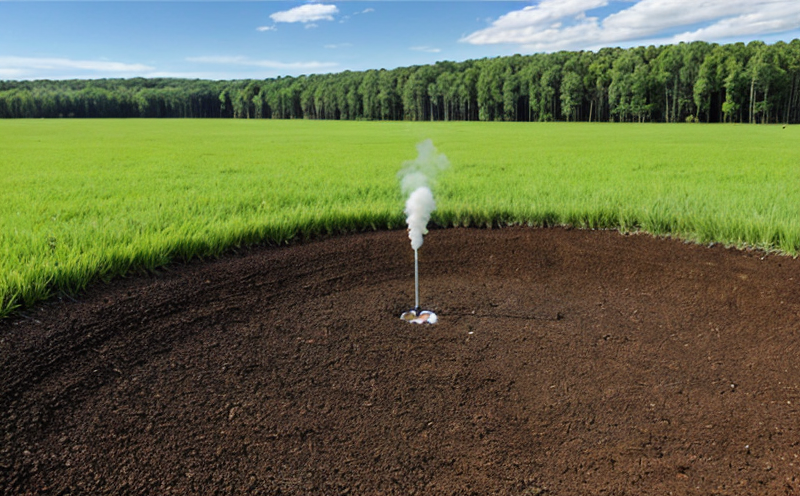DIN 19738 Trace Elements in Soil Impact Testing
The DIN 19738 standard is a cornerstone of environmental quality assessment and compliance for mining operations. This method specifically addresses the determination of trace elements in soil, which are critical indicators of potential environmental impact. Mining activities can introduce various harmful substances into the environment through dust emissions, runoff from waste rock piles, or tailings disposal. Trace elements such as lead (Pb), cadmium (Cd), and arsenic (As) are often present in elevated concentrations that could pose risks to human health and ecosystems.
The testing protocol outlined by DIN 19738 is designed to ensure that mining activities do not exceed safe thresholds for these trace elements. The method involves soil sampling, preparation, digestion, and subsequent analysis using atomic absorption spectrometry (AAS) or inductively coupled plasma mass spectrometry (ICP-MS). The standard specifies the exact procedures to follow at each step, from sample collection to final measurement.
The importance of this testing cannot be overstated. Mining operations are highly regulated industries, and compliance with such standards is essential for maintaining operational permits. Non-compliance can lead to significant fines, reputational damage, and even closure of mining sites. Therefore, it is imperative that quality managers and R&D engineers understand the nuances of DIN 19738 and ensure that their teams are equipped with the necessary expertise.
The testing process begins with soil sampling, which must be conducted in a manner that ensures representativeness. Sampling depth and frequency are critical parameters that should align with the specific requirements of the project. Once collected, samples undergo thorough preparation, including drying, grinding, and sieving to ensure consistency. The digestion step is particularly crucial as it allows for the release of trace elements from their bound forms in soil particles.
After digestion, the sample solution is analyzed using AAS or ICP-MS. These instruments provide highly precise measurements that are necessary for accurate determination of trace element concentrations. The results are then compared against established environmental thresholds to assess compliance with regulatory limits. This process not only helps mining companies comply with legal requirements but also provides valuable insights into potential risks and mitigation strategies.
Understanding the scope, apparatus, and acceptance criteria is essential for successful implementation of DIN 19738. The standard specifies the use of specific equipment such as digestion furnaces, AAS or ICP-MS instruments, and various reagents. Compliance with these standards ensures reliable and reproducible results, which are crucial for effective environmental impact assessment.
Why It Matters
The significance of DIN 19738 trace elements in soil testing goes beyond mere compliance; it plays a pivotal role in safeguarding public health and the environment. Mining activities can introduce harmful substances into the ecosystem, leading to soil contamination that may affect local flora and fauna, as well as human populations. Trace elements such as lead, cadmium, and arsenic are particularly concerning due to their potential to cause serious health issues when present at elevated levels.
By implementing DIN 19738 testing protocols, mining companies can proactively manage these risks. The test results provide actionable data that can inform decision-making processes regarding operational adjustments, waste management practices, and reclamation strategies. This proactive approach not only enhances the company's environmental responsibility but also contributes to improved community relations.
The benefits of adhering to DIN 19738 extend beyond compliance; it fosters a culture of continuous improvement in environmental stewardship. By regularly monitoring soil quality through this testing method, mining companies can identify emerging issues early and implement corrective measures before they escalate into larger problems. This proactive stance is not only beneficial for the environment but also helps to maintain a positive reputation among stakeholders.
Moreover, DIN 19738 testing supports sustainable development by ensuring that mining operations are conducted in an environmentally responsible manner. The results of these tests can be used to develop and implement best practices that minimize adverse impacts on ecosystems. This commitment to sustainability is increasingly important as the global community places greater emphasis on environmental protection.
In conclusion, DIN 19738 trace elements in soil testing is a critical component of environmental management for mining operations. It ensures compliance with regulatory standards while providing valuable data for risk assessment and mitigation. By adopting this approach, companies can contribute to a more sustainable future and protect the environment for generations to come.
Environmental and Sustainability Contributions
- Emission Reduction: By identifying and mitigating sources of trace element release into the environment, DIN 19738 testing helps reduce harmful emissions from mining operations.
- Resource Optimization: The results of these tests can guide efforts to optimize resource use and minimize waste generation.
- Ecosystem Protection: Regular monitoring through DIN 19738 ensures that mining activities do not compromise the integrity of local ecosystems.
- Sustainable Development: Compliance with DIN 19738 aligns mining operations with broader sustainability goals, promoting long-term environmental stewardship.
Use Cases and Application Examples
| Scenario | Testing Parameters | Expected Outcomes |
|---|---|---|
| Post-Mining Site Closure | Determination of trace elements in soil around the site; comparison against baseline data. | Evaluation of post-closure impact on local environment and identification of areas for remediation. |
| Routine Monitoring | Periodic sampling and analysis to track changes in soil quality over time. | Identification of potential environmental risks early, allowing for timely interventions. |
| New Project Site Assessment | Determination of baseline levels of trace elements before initiation of mining activities. | Establishment of a reference point for future monitoring and compliance assessment. |
The use cases highlighted above illustrate the versatility and importance of DIN 19738 testing in the context of environmental impact assessment. These tests are essential tools for mining companies to ensure that their operations do not compromise ecological balance or human health.





